L37-动词词组的构造原理 初中英语词性句法新讲课件
文档属性
| 名称 | L37-动词词组的构造原理 初中英语词性句法新讲课件 |
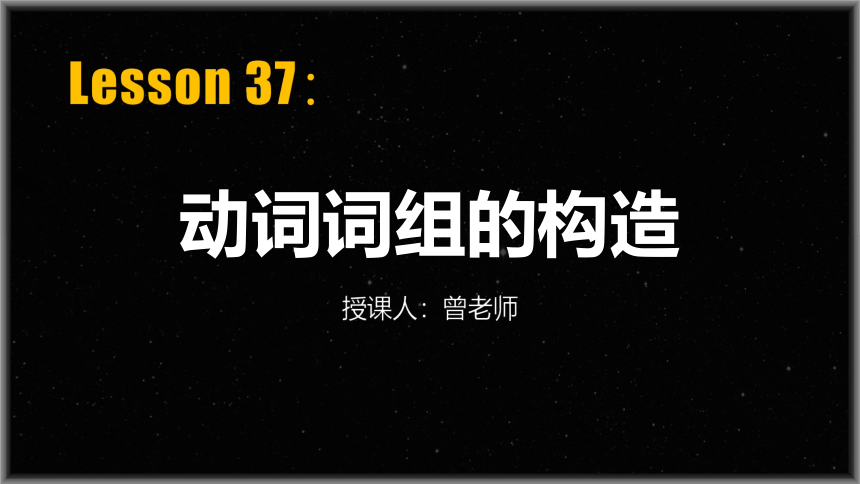
|
|
| 格式 | ppt | ||
| 文件大小 | 1.1MB | ||
| 资源类型 | 试卷 | ||
| 版本资源 | 通用版 | ||
| 科目 | 英语 | ||
| 更新时间 | 2022-04-11 09:59:44 | ||
图片预览

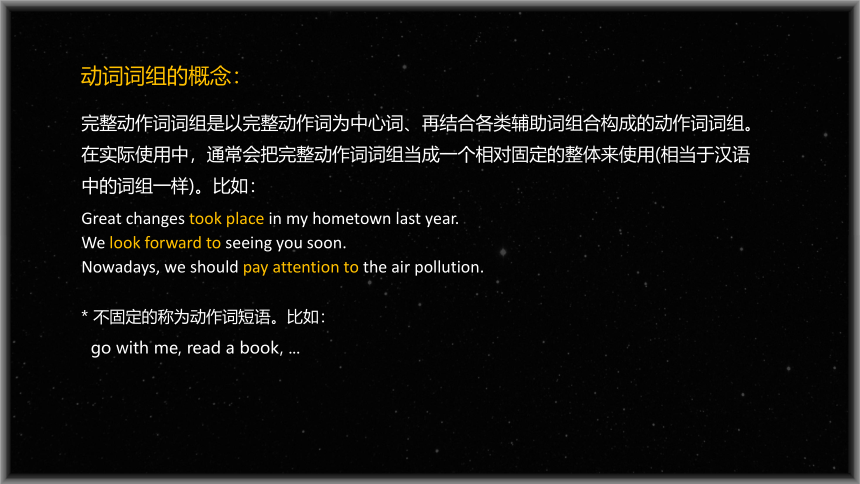
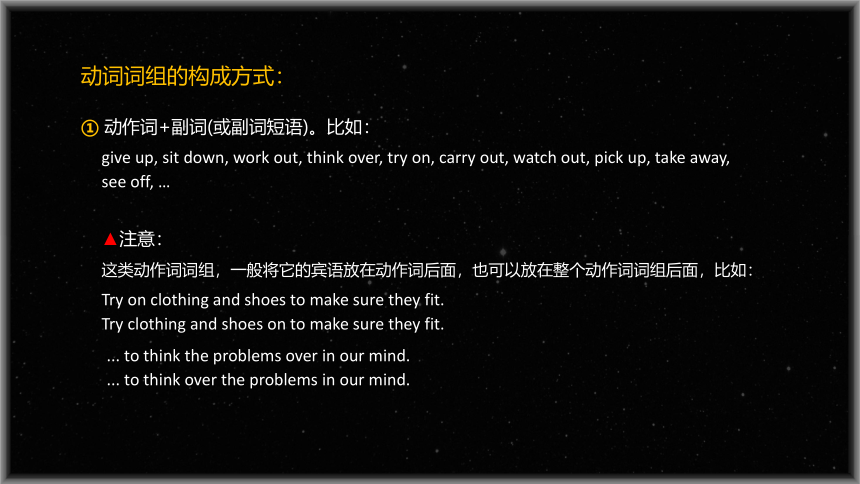
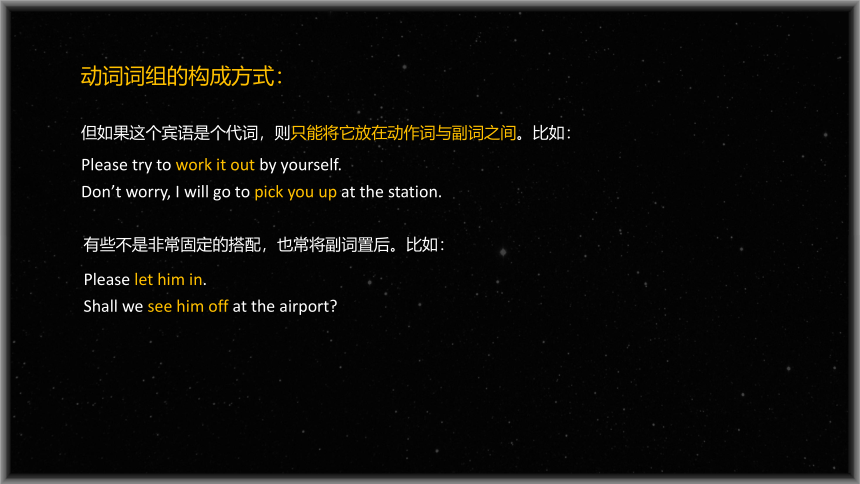
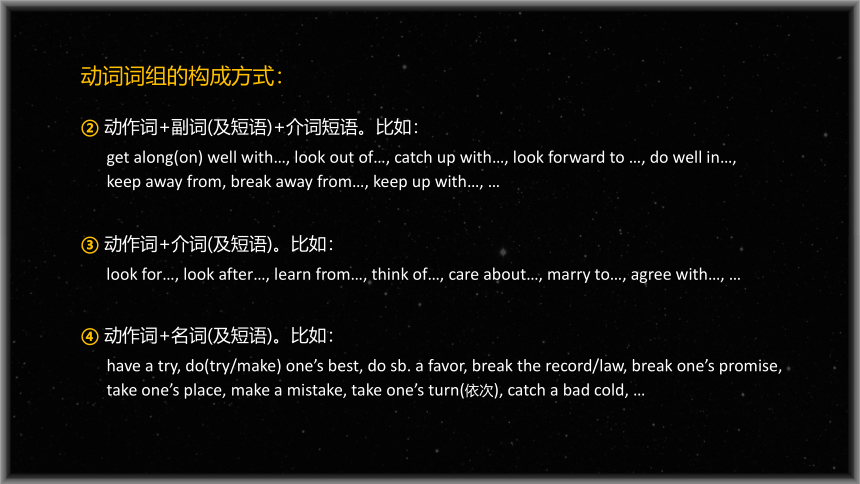
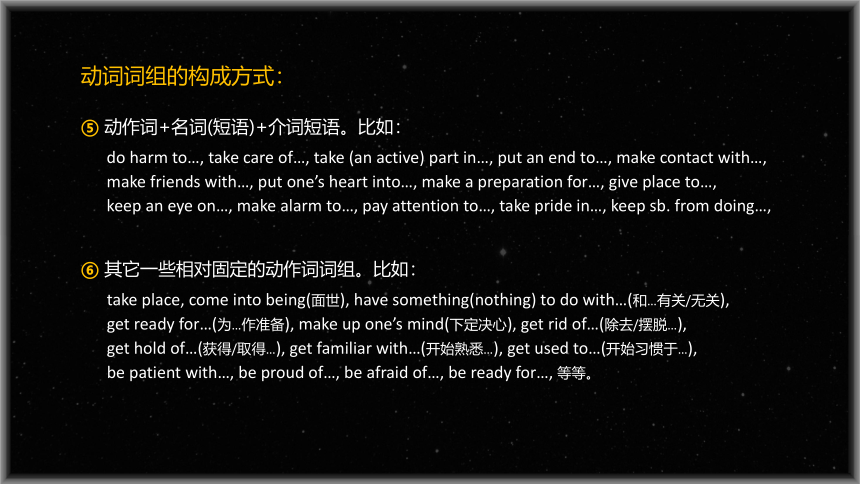

文档简介
(共16张PPT)
动词词组的构造
Lesson 37:
授课人:曾老师
动词词组的概念:
完整动作词词组是以完整动作词为中心词、再结合各类辅助词组合构成的动作词词组。
在实际使用中,通常会把完整动作词词组当成一个相对固定的整体来使用(相当于汉语
中的词组一样)。比如:
Great changes took place in my hometown last year.
We look forward to seeing you soon.
Nowadays, we should pay attention to the air pollution.
* 不固定的称为动作词短语。比如:
go with me, read a book, ...
动词词组的构成方式:
give up, sit down, work out, think over, try on, carry out, watch out, pick up, take away,
see off, …
① 动作词+副词(或副词短语)。比如:
Try on clothing and shoes to make sure they fit.
Try clothing and shoes on to make sure they fit.
▲注意:
这类动作词词组,一般将它的宾语放在动作词后面,也可以放在整个动作词词组后面,比如:
... to think the problems over in our mind.
... to think over the problems in our mind.
动词词组的构成方式:
Please try to work it out by yourself.
Don’t worry, I will go to pick you up at the station.
但如果这个宾语是个代词,则只能将它放在动作词与副词之间。比如:
有些不是非常固定的搭配,也常将副词置后。比如:
Please let him in.
Shall we see him off at the airport
动词词组的构成方式:
get along(on) well with…, look out of…, catch up with…, look forward to …, do well in…,
keep away from, break away from…, keep up with…, …
② 动作词+副词(及短语)+介词短语。比如:
look for…, look after…, learn from…, think of…, care about…, marry to…, agree with…, …
③ 动作词+介词(及短语)。比如:
have a try, do(try/make) one’s best, do sb. a favor, break the record/law, break one’s promise,
take one’s place, make a mistake, take one’s turn(依次), catch a bad cold, …
④ 动作词+名词(及短语)。比如:
动词词组的构成方式:
do harm to…, take care of…, take (an active) part in…, put an end to…, make contact with…, make friends with…, put one’s heart into…, make a preparation for…, give place to…,
keep an eye on…, make alarm to…, pay attention to…, take pride in…, keep sb. from doing…,
⑤ 动作词+名词(短语)+介词短语。比如:
take place, come into being(面世), have something(nothing) to do with…(和…有关/无关),
get ready for…(为…作准备), make up one’s mind(下定决心), get rid of…(除去/摆脱…),
get hold of…(获得/取得…), get familiar with…(开始熟悉…), get used to…(开始习惯于…),
be patient with…, be proud of…, be afraid of…, be ready for…, 等等。
⑥ 其它一些相对固定的动作词词组。比如:
如何理解动词词组的含义:
动词词组是动词的“丰富化”形式。
动作词后面加上辅助词等组合构成动词词组后,它就象“孙悟空”得到了“金箍棒”,表述意思的
能力一下大增。从语言学这个角度来说,通过这种方式,对动作的表述可以更加精准到位。
关于动词词组的表述意思,所谓万变不离其“宗”,只要掌握了动作词的本意、辅助词的本意,
动词词组的基本意就可以“手到擒来” 。当然产生的“引申义”,则需要化点时间去记一记。
如何理解动词词组的含义:
动词词组的意思,基本上是“动作词本意+介词/副词本意”产生出来的“引申义”,掌握这点,
稍加注意一下就可以记住这些词组的意思。比如:
look after…
“look”意为“看”
“after”意为“在…之后”
连起来引申为“照看照料…”
look for…
“for”意为“为了…”
连起来引申为“寻找…”
look up…
look up a word in the dictionary
“up”意为“往上…”
连起来“向上看…”,引申为“瞻仰/仰慕…”
代表对知识的仰慕
look down
“down”意为“向下…”
连起来“往下看…”,引申为“鄙视…”
look up and down
连起来“上上下下地看/打量…”
look through
连起来“从头到尾看一遍/粗看…”
“through”意为“穿过…”
look back
连起来“往后…”,引伸为“回顾…”
“back”意为“往向…”
look around
连起来为“环顾四周…”
“around”意为“四周…”
如何理解完整动作词组的含义:
find out…
“find”意为“寻找”
连起来引申为“找出来”
work out…
“work”意为“工作”
连起来引申为“通过工作后得出…”
look out
“look”意为“看”
连起来引申为“看外面”
watch out
“watch”意为“仔细看”
连起来引申为“当心”
get out
“get”意为“得到”
连起来引申为“出来/出去”
“out”意为“出来/在外面的”:
如何理解完整动作词组的含义:
learn from…
“learn”意为“学习…”
引申为“从…处学到…”
tell from…
“tell”意为“识别…”
引申为“从…处分辨出来…”
stop sb. from…
“stop”意为“阻止…”
引申为“把某人从某事中拉出来…”
differ from…
“differ”意为“不相同”
引申为“不同于/异于…”
“from”意为“从…处出来/过来”:
(be different from…)
状态描述:“跟…对比后是不同的”
动词词组区分常考题:
take away
take out
take off
take after
take back
take in
take on
take up
take up with
take down
take over
take care (of...)
拿走,带走
拿出...,把...带到外面(带出去);除去...;
脱掉;起飞;请假
外表行为举止上像...
收回撤回;退回
收容收留;理解领会
承担接受(任务责任);呈现出(新面貌);让客人上(船/车...)
开始从事或处理...
忙于...
从(高处)取下来...;记录或写下...;打倒...
接收接管...;接任接手...;取代...
小心;小心照看...
动词词组区分常考题:
get up
get out
get in
...
起床/起身;站起来;使…起床
逃离/被迫离开/外出;退出(组织) ;收回(承诺) ;(消息、信息等)泄露/被别人知道
到达/抵达...;收获/收割/把...收进来;当选/入围
set up
set out
set off
...
建立/设立/组建/创建;;搭建/立起...;创业/开业
动身出发;着手开始(干)...;摆放陈列...;阐述说明...;
动身出发离开(某地);引发/触发/激起...
动词词组区分常考题:
give a new turn to ...
in one’s turn
out of turn
take one’s turn to do
turn a blind eye to
turn against
turn back
turn down
turn into
turn off
turn on
turn down
turn one’s attention to ..
turn out
turn out to be
turn over a new leaf
turn around
turn to
turn to ... for help
turn upside down
turn over
catch the ball
catch a bad cold
be caught in the rain
be caught in the storm
▲ “get on, get on ..., get ... on, get ... on ...” :
Stop dithering(犹豫不决) and get on with it.
Parents often teach us how to get on well with others.
1). “get on”中的“on”为副词, “on”表示“动作的继续” 。比如:
动词词组短语中,介词与副词的区别:
The bus is too crowed. It’s difficult to get on it.
Just collect all the materials you need and get on work.
You should get on it immediately.
2). “get on ...”中的“on”为介词,表示“登上...;继续(做)....” 。比如:
类似的短语还有:
Let’s go on.
动词词组短语中,介词与副词的区别:
The dog can’t get on the bus by itself. Let’s get it on.
This play is wonderful. We will get it on next week.
The T-shirt looks great. Please just get it on soon.
Yeah, my man is going to get it on tonight. So we can have a wonderful time in his restaurant.
3). “get ... on”中的“on”也为副词(补足语修饰前面的宾语), 表示“使...登上...;让...上演/开张/
穿上” 等。比如:
4). “get ... on ...”中的“on”为介词,但有二种情况:
动词词组短语中,介词与副词的区别:
* 一种是介词短语修饰动作词,用来说明动作词的发生方式。比如:
You only get it on the way home.
You can get the news on your radio too.
This kind of wine is not allowed to be sold. We can only get it on the black market.
* 一种是补充说明前面的宾语,用作宾补。比如:
Get the hat on his head.
Once you get it on your mind, it’s hard to concentrate on(专注于) anything else.
动词词组的构造
Lesson 37:
授课人:曾老师
动词词组的概念:
完整动作词词组是以完整动作词为中心词、再结合各类辅助词组合构成的动作词词组。
在实际使用中,通常会把完整动作词词组当成一个相对固定的整体来使用(相当于汉语
中的词组一样)。比如:
Great changes took place in my hometown last year.
We look forward to seeing you soon.
Nowadays, we should pay attention to the air pollution.
* 不固定的称为动作词短语。比如:
go with me, read a book, ...
动词词组的构成方式:
give up, sit down, work out, think over, try on, carry out, watch out, pick up, take away,
see off, …
① 动作词+副词(或副词短语)。比如:
Try on clothing and shoes to make sure they fit.
Try clothing and shoes on to make sure they fit.
▲注意:
这类动作词词组,一般将它的宾语放在动作词后面,也可以放在整个动作词词组后面,比如:
... to think the problems over in our mind.
... to think over the problems in our mind.
动词词组的构成方式:
Please try to work it out by yourself.
Don’t worry, I will go to pick you up at the station.
但如果这个宾语是个代词,则只能将它放在动作词与副词之间。比如:
有些不是非常固定的搭配,也常将副词置后。比如:
Please let him in.
Shall we see him off at the airport
动词词组的构成方式:
get along(on) well with…, look out of…, catch up with…, look forward to …, do well in…,
keep away from, break away from…, keep up with…, …
② 动作词+副词(及短语)+介词短语。比如:
look for…, look after…, learn from…, think of…, care about…, marry to…, agree with…, …
③ 动作词+介词(及短语)。比如:
have a try, do(try/make) one’s best, do sb. a favor, break the record/law, break one’s promise,
take one’s place, make a mistake, take one’s turn(依次), catch a bad cold, …
④ 动作词+名词(及短语)。比如:
动词词组的构成方式:
do harm to…, take care of…, take (an active) part in…, put an end to…, make contact with…, make friends with…, put one’s heart into…, make a preparation for…, give place to…,
keep an eye on…, make alarm to…, pay attention to…, take pride in…, keep sb. from doing…,
⑤ 动作词+名词(短语)+介词短语。比如:
take place, come into being(面世), have something(nothing) to do with…(和…有关/无关),
get ready for…(为…作准备), make up one’s mind(下定决心), get rid of…(除去/摆脱…),
get hold of…(获得/取得…), get familiar with…(开始熟悉…), get used to…(开始习惯于…),
be patient with…, be proud of…, be afraid of…, be ready for…, 等等。
⑥ 其它一些相对固定的动作词词组。比如:
如何理解动词词组的含义:
动词词组是动词的“丰富化”形式。
动作词后面加上辅助词等组合构成动词词组后,它就象“孙悟空”得到了“金箍棒”,表述意思的
能力一下大增。从语言学这个角度来说,通过这种方式,对动作的表述可以更加精准到位。
关于动词词组的表述意思,所谓万变不离其“宗”,只要掌握了动作词的本意、辅助词的本意,
动词词组的基本意就可以“手到擒来” 。当然产生的“引申义”,则需要化点时间去记一记。
如何理解动词词组的含义:
动词词组的意思,基本上是“动作词本意+介词/副词本意”产生出来的“引申义”,掌握这点,
稍加注意一下就可以记住这些词组的意思。比如:
look after…
“look”意为“看”
“after”意为“在…之后”
连起来引申为“照看照料…”
look for…
“for”意为“为了…”
连起来引申为“寻找…”
look up…
look up a word in the dictionary
“up”意为“往上…”
连起来“向上看…”,引申为“瞻仰/仰慕…”
代表对知识的仰慕
look down
“down”意为“向下…”
连起来“往下看…”,引申为“鄙视…”
look up and down
连起来“上上下下地看/打量…”
look through
连起来“从头到尾看一遍/粗看…”
“through”意为“穿过…”
look back
连起来“往后…”,引伸为“回顾…”
“back”意为“往向…”
look around
连起来为“环顾四周…”
“around”意为“四周…”
如何理解完整动作词组的含义:
find out…
“find”意为“寻找”
连起来引申为“找出来”
work out…
“work”意为“工作”
连起来引申为“通过工作后得出…”
look out
“look”意为“看”
连起来引申为“看外面”
watch out
“watch”意为“仔细看”
连起来引申为“当心”
get out
“get”意为“得到”
连起来引申为“出来/出去”
“out”意为“出来/在外面的”:
如何理解完整动作词组的含义:
learn from…
“learn”意为“学习…”
引申为“从…处学到…”
tell from…
“tell”意为“识别…”
引申为“从…处分辨出来…”
stop sb. from…
“stop”意为“阻止…”
引申为“把某人从某事中拉出来…”
differ from…
“differ”意为“不相同”
引申为“不同于/异于…”
“from”意为“从…处出来/过来”:
(be different from…)
状态描述:“跟…对比后是不同的”
动词词组区分常考题:
take away
take out
take off
take after
take back
take in
take on
take up
take up with
take down
take over
take care (of...)
拿走,带走
拿出...,把...带到外面(带出去);除去...;
脱掉;起飞;请假
外表行为举止上像...
收回撤回;退回
收容收留;理解领会
承担接受(任务责任);呈现出(新面貌);让客人上(船/车...)
开始从事或处理...
忙于...
从(高处)取下来...;记录或写下...;打倒...
接收接管...;接任接手...;取代...
小心;小心照看...
动词词组区分常考题:
get up
get out
get in
...
起床/起身;站起来;使…起床
逃离/被迫离开/外出;退出(组织) ;收回(承诺) ;(消息、信息等)泄露/被别人知道
到达/抵达...;收获/收割/把...收进来;当选/入围
set up
set out
set off
...
建立/设立/组建/创建;;搭建/立起...;创业/开业
动身出发;着手开始(干)...;摆放陈列...;阐述说明...;
动身出发离开(某地);引发/触发/激起...
动词词组区分常考题:
give a new turn to ...
in one’s turn
out of turn
take one’s turn to do
turn a blind eye to
turn against
turn back
turn down
turn into
turn off
turn on
turn down
turn one’s attention to ..
turn out
turn out to be
turn over a new leaf
turn around
turn to
turn to ... for help
turn upside down
turn over
catch the ball
catch a bad cold
be caught in the rain
be caught in the storm
▲ “get on, get on ..., get ... on, get ... on ...” :
Stop dithering(犹豫不决) and get on with it.
Parents often teach us how to get on well with others.
1). “get on”中的“on”为副词, “on”表示“动作的继续” 。比如:
动词词组短语中,介词与副词的区别:
The bus is too crowed. It’s difficult to get on it.
Just collect all the materials you need and get on work.
You should get on it immediately.
2). “get on ...”中的“on”为介词,表示“登上...;继续(做)....” 。比如:
类似的短语还有:
Let’s go on.
动词词组短语中,介词与副词的区别:
The dog can’t get on the bus by itself. Let’s get it on.
This play is wonderful. We will get it on next week.
The T-shirt looks great. Please just get it on soon.
Yeah, my man is going to get it on tonight. So we can have a wonderful time in his restaurant.
3). “get ... on”中的“on”也为副词(补足语修饰前面的宾语), 表示“使...登上...;让...上演/开张/
穿上” 等。比如:
4). “get ... on ...”中的“on”为介词,但有二种情况:
动词词组短语中,介词与副词的区别:
* 一种是介词短语修饰动作词,用来说明动作词的发生方式。比如:
You only get it on the way home.
You can get the news on your radio too.
This kind of wine is not allowed to be sold. We can only get it on the black market.
* 一种是补充说明前面的宾语,用作宾补。比如:
Get the hat on his head.
Once you get it on your mind, it’s hard to concentrate on(专注于) anything else.
同课章节目录
- 词法
- 名词
- 动词和动词短语
- 动词语态
- 动词时态
- 助动词和情态动词
- 非谓语动词
- 冠词
- 代词
- 数词和量词
- 形容词副词及其比较等级
- 介词和介词短语
- 连词和感叹词
- 构词法
- 相似、相近词比较
- 句法
- 陈述句
- 一般疑问句和否定疑问句
- 特殊疑问句及选择疑问句
- 反意疑问句
- 存在句(There be句型)
- 宾语从句
- 定语从句
- 状语从句
- 主谓一致问题
- 简单句
- 并列句
- 复合句
- 主谓一致
- 主、表语从句
- 名词性从句
- 直接引语和间接引语
- 虚拟语气
- 感叹句
- 强调句
- 倒装句
- 祈使句
- 句子的成分
- 句子的分类
- 题型专区
- 单项选择部分
- 易错题
- 完形填空
- 阅读理解
- 词汇练习
- 听说训练
- 句型转换
- 补全对话
- 短文改错
- 翻译
- 书面表达
- 任务型阅读
- 语法填空
- 其他资料
